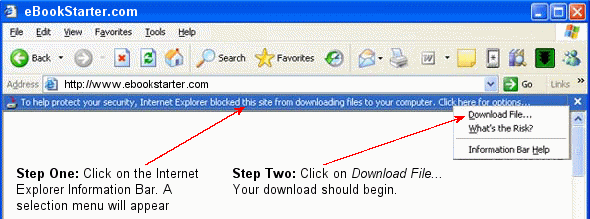Creating a Template eBook Using the Wizard
 Creating a Template eBook Using the Wizard
Creating a Template eBook Using the Wizard
Following is a step by step guide to assist you in creating your eBook using the Wizard.
![]() Selecting Your eBook Preference
Selecting Your eBook Preference
To begin creating your eBook, click on the 'Wizard' icon on the eBook Starter toolbar. When the 'Wizard' window opens, select the 'Create an eBook from a template' option and click on 'Next.'
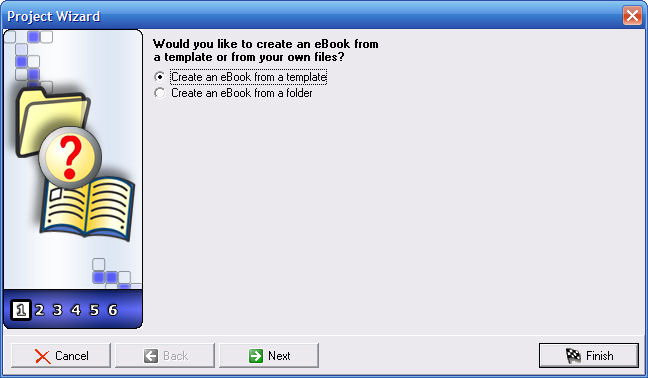
![]() Selecting Your Template
Selecting Your Template
Your next step will be to select a template for your ebook. If you haven't already done so, you may want to visit the 'Template Download' page to pick up some additional templates for your software. Go to 'Help' - 'Download Templates' on the eBook Starter toolbar. You will find step by step instructions on the download page to assist you in getting them installed.
When you're ready to select a template, click on each template set to preview it within the preview window. Make sure you double click on the template files, as this will enable you to see exactly what pages are included within each template. Some templates include the Front Cover, Introduction, About, Foreword, Blank Pages and Back Cover, while others only include the Front Cover, Blank Pages and Back Cover.
In addition, some of the templates have Chapter Folders, while others don't. Make sure you carefully go through the templates to select the template that is right for your project.
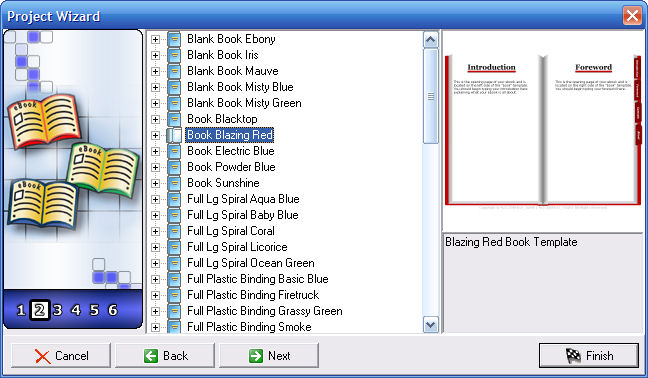
Once you have selected the template you'd like to use, click on the template to highlight and then on 'Next.'
![]() Selecting Your eBook's Display and Output Options
Selecting Your eBook's Display and Output Options
Once you have selected your template, your next step will be to select your ebook's options.
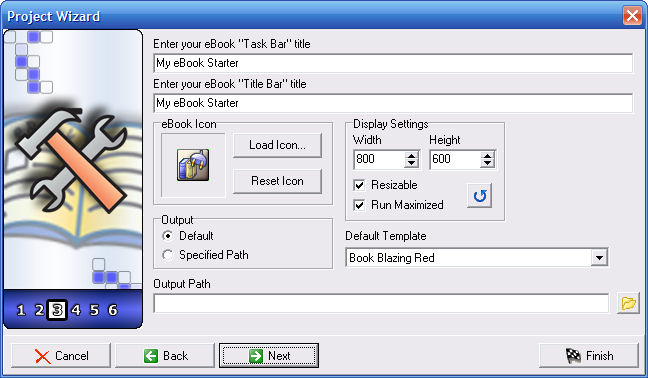
Fill in your preferences for all of the following options:
- Enter your eBook "Task Bar" Title (This title will be displayed at the bottom of the screen within the task bar when your eBook is minimized.)
- Enter your eBook "Title Bar" Title (This title will be displayed within the eBook's title bar, which is the blue title bar at the top of your eBook's window.)
- eBook Icon (The icon that is displaying within this section will be used to access your eBook when it is completed. You can use your own icon by clicking on the 'Load Icon' button. Icons must be in ICO format and must be 32 x 32 pixels in size.)
- Display Settings (This will determine the size of your ebook. You can also specify whether or not it should be resizable and specify that it should open maximized.)
- Output Path (Click on the yellow folder to select where you would like your ebook to be placed when it is compiled. In addition, you will need to type in a name for your ebook file. Make sure your file name is as short as possible, contains only letters and/or numbers and contains no spaces.)
Once you've selected your options, click on 'Next.'
For additional information on selecting your options (such as General, Security, Toolbar, and Splash), see the 'Selecting Your eBook's Options' section.
![]() Selecting Your eBook's Toolbar Options
Selecting Your eBook's Toolbar Options
Once you have selected your ebook's display settings, your next step will be to select your ebook's toolbar options.
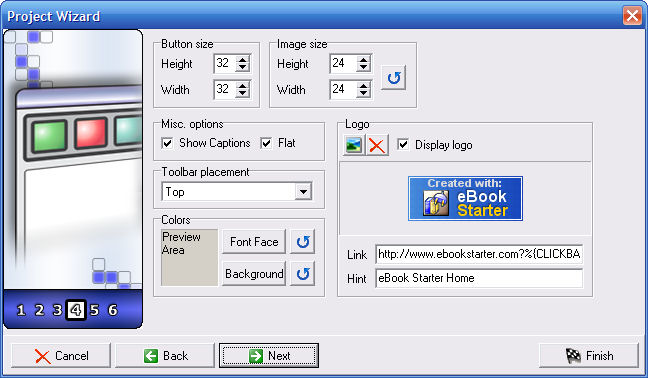
Fill in your preferences for all of the following options:
- Button size (The toolbar button size determines the size of your toolbar buttons displayed within your ebook. Edit the button's height and width to suit your needs. The button sizes are displayed in pixels.)
- Image size ( The toolbar image size determines the size of the image displayed on your ebook's toolbar buttons. Edit the button image's height and width to suit your needs. The image sizes are displayed in pixels.)
- Misc. options (Check the 'Show Caption' option if you'd like to show the caption (text) with the toolbar buttons. Check the 'Flat' option if you'd like to display the toolbar buttons flat instead of three dimensional.)
- Logo (You have the option to display a custom logo within your eBooks that may be linked to the web site of your choice. Custom logos should not be larger than your button height and must be in BMP format. The default logo is an affiliate link to the eBook Starter site.)
- Toolbar placement (Select the 'Top' option if you would like to display your eBook's toolbar at the top. Select the 'Bottom' option if you would like to display your eBook's toolbar at the bottom. Select the 'None' option if you would prefer not to display a toolbar within your eBook.
- Toolbar Colors (Select your preferred colors for your toolbar background and font face. However, if you will be displaying button captions (text), make sure your text is clearly visible through your selected background color.)
Specify your preferred options and click on 'Next.'
Note: These options can be changed later by clicking on the 'Options' button on the eBook Starter toolbar.
For additional information on selecting your options (such as General, Security, Toolbar, and Splash), see the 'Selecting Your eBook's Options' section.
![]() Selecting Your eBook's Security Options
Selecting Your eBook's Security Options
In step five of the wizard, you will have the opportunity to select your ebook's security options.

Select your preferences from the following options:
- Security
- No Security (This option will enable your eBook to be opened without a password or any additional security options.)
- Key File (This option will ensure your eBook is only viewed on one computer. Although this security method is the most time-consuming, as you must process each individual customer's security information, it is the most secure.)
- Password (This option will enable you to protect your eBook with a single password.)
- Individual Usernames and Passwords (This option is identical to the 'Password' option. However, this option works with one or more 'username-password' pairs.)
- Password Protect Type
- All Book (Simple) (Protect your complete eBook with a password. When the user tries to open your ebook, they will be asked to enter a password.)
- All Book (Shareware) (This option will enable you to create a shareware version of your eBook. A shareware version will enable you to allow your users to view your eBook a certain number of days or starts (opens). Once the allotted time has passed, the reader will be required to enter a password to continue reading your eBook.)
- Selected Pages (Select this option if you would like to password protect certain pages, while enabling your users to view other pages.)
- Allow Right Click
-
Allow (Select this option to enable your users to use their right click mouse menu. This option would enable them to highlight your text and copy it.)
-
Don't Allow (Select this option to prevent your users from using their right click mouse menu. This option would prevent them from highlighting your text and copying it.)
-
Custom (Select this option to specify the right mouse click option for each individual file within your 'Project' window.)
-
- Run Key Maker (Use this button to create ebook keys for your customers. See 'Security' - 'Key File' within the 'Selecting Your eBook's Options' section for further information.)
Specify your preferred options and click on 'Next.'
Note: These options can be changed later by clicking on the 'Options' button on the eBook Starter toolbar.
For additional information on selecting your options (such as General, Security, Toolbar, and Splash), see 'Selecting Your eBook's Options' section.
![]() Selecting Your eBook's Starting/Ending Options
Selecting Your eBook's Starting/Ending Options
Step six will enable you to include your own starting and/or ending splash screens and pop-up boxes.
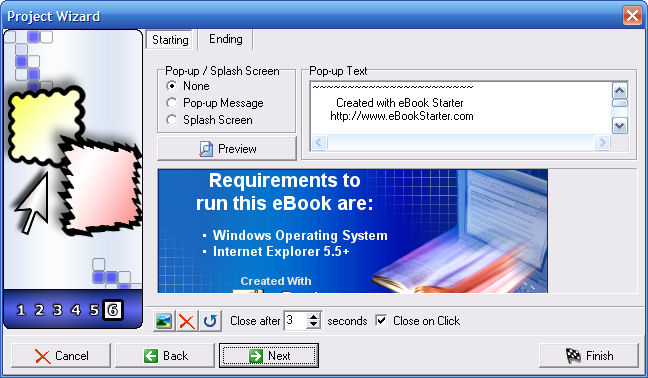
Select your preferences from the following options:
- Starting and Ending Options (Select your preferences for displaying a 'Starting' and/or 'Ending' splash and/or pop-up window.)
- Pop-up / Splash Screen
-
None ( Select this option if you don't want to display any 'Starting' or 'Ending' messages.)
-
Pop-up Message (Select this option if you'd like to display an 'Alert' type pop-up message. You can use this option to tell your readers about your eBook, the requirements to view your eBook, or whatever you'd like.)
-
Splash Screen (Select this option if you'd like to display a custom splash screen. Splash images can be the size of your choice; however, the image must be in BMP format. Click on the 'picture' icon to load your image. If you need to delete an image, click on the 'Red X.' You can see how your splash screen will look by clicking on the 'Preview' button.)
-
- Pop-up Text (If you've elected to display a 'Starting' and/or 'Ending' pop-up alert window, type your alert text within the text area. You can preview your pop-up by clicking on the 'Preview' button.)
-
Close after ? seconds (Select the number of seconds the splash screen should display before closing. It is highly recommended that you not display the splash screen for any longer than 4 seconds, as this may irritate your readers.)
-
Close on click (Check this option to close the splash screen when clicked on. It is highly recommended that you enable your readers to close your splash screen on click.)
Specify your preferred options and click on 'Next.'
Note: These options can be changed later by clicking on the 'Options' button on the eBook Starter toolbar.
For additional information on selecting your options (such as General, Security, Toolbar, and Splash), see 'Selecting Your eBook's Options' section.
![]() Selecting Your eBook's Finish Options
Selecting Your eBook's Finish Options
This is the final 'Wizard' step that will enable you to either compile your ebook or continue on to the editing area.
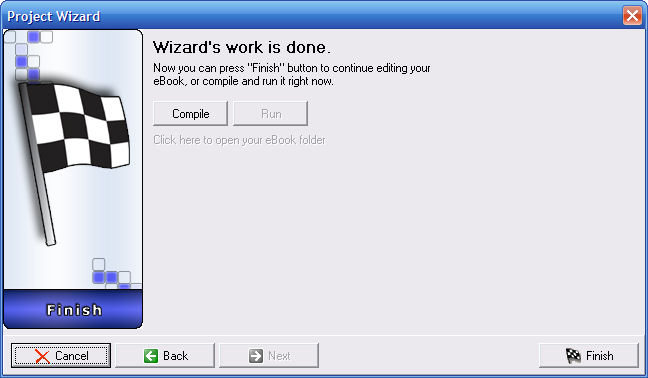
As you are creating your ebook using one of the eBook Starter templates, you will need to continue on to the editing area. Click on 'Finish' to continue. Your files should now be displayed within the 'Project' window.
To open your 'Project' window, click on the 'Project' tab:
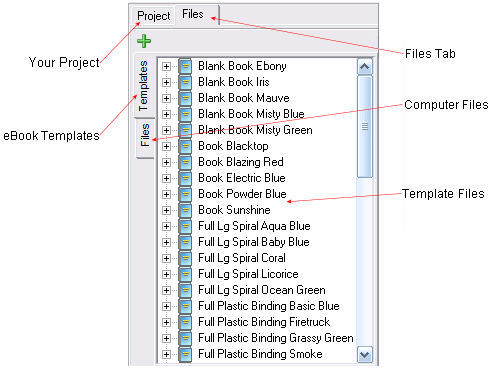
![]() Creating Your Story Tree
Creating Your Story Tree
Once your selected template is displaying within your 'Project' window, you can begin setting up your ebook's story tree. A story tree is simply the structure of your ebook. For example, your ebook's story tree might begin with the Front Cover, which will be the first page displayed when your ebook is opened, and end with the Back Cover, which will be the last page displayed. All of the other pages between the Front and Back Cover are your ebook's pages.
For example, if you've selected a template with an Introduction, this page may be in your story tree's second position, which means it will be the second page displayed within your ebook. If your template has a Table of Contents, this page may be in your story tree's third position, which means it will be the third page displayed within your ebook.
Here's how your 'Project' window might look:

To create your story tree, simply click on the '![]() Insert Chapter' button to add a '
Insert Chapter' button to add a '![]() Chapter.' A new '
Chapter.' A new '![]() Chapter' will be added each time you click on the button.
Chapter' will be added each time you click on the button.
If you'd like to add a '![]() Sub Chapter' within a chapter, click on your chapter to highlight and then on the '
Sub Chapter' within a chapter, click on your chapter to highlight and then on the '![]() Add Sub Chapter' button at the top of the 'Project' window.
Add Sub Chapter' button at the top of the 'Project' window.
To add '![]() Pages' to your chapters, click on the chapter in which you'd like to add a page to highlight and then on the '
Pages' to your chapters, click on the chapter in which you'd like to add a page to highlight and then on the '![]() Add Default Page' arrow and select the page you would like to add. Repeat this process for each chapter.
Add Default Page' arrow and select the page you would like to add. Repeat this process for each chapter.
Here's how your chapters, sub chapters and pages might look:
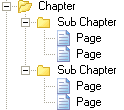
Please note, the purpose of chapters is to enable you to display your chapter titles within your Table of Contents and to enable you to keep your ebook files organized -- that's it. If you'd rather not include them, you certainly don't have to, as you can elect to have your 'Page' titles display in the Table of Contents as well.
You can set your story tree up however you'd like. However, make sure you place your files in the order in which you would like them to be viewed when your ebook is opened.
![]() Working with Your Files
Working with Your Files
Once you've set up your story tree, your next step will be to select your '![]() Chapter' and '
Chapter' and '![]() Page' options. This might include all of the following:
Page' options. This might include all of the following:
- Edit/Preview Your Pages - Click on the
 button to edit and/or preview your '
button to edit and/or preview your ' Pages' within the editor. (Editing option available for use with templates only)
Pages' within the editor. (Editing option available for use with templates only) - Editing Your Chapter / Page Titles - Click on the
 button to edit your '
button to edit your ' Chapter' and '
Chapter' and ' Page' titles.
Page' titles. - Placing Your Pages in Order - Click on the

 buttons to place your '
buttons to place your ' Pages' in order -- beginning with your opening '
Pages' in order -- beginning with your opening ' Page.'
Page.' - Adding a New Chapter - Click on the
 button to add a new '
button to add a new ' Chapter' and/or '
Chapter' and/or ' Sub Chapter.'
Sub Chapter.' - Deleting a Chapter / File - Click on the
 button to delete a '
button to delete a ' Chapter' or '
Chapter' or ' Page.'
Page.' - Adding a New Page - Click on the
 arrow to select and add a new '
arrow to select and add a new ' Page.' (For use with templates only)
Page.' (For use with templates only) -
Clearing the Story Tree - Click on the
 button to clear the entire story tree. Note: Use this option with care, as it will delete your entire ebook.
button to clear the entire story tree. Note: Use this option with care, as it will delete your entire ebook.
To select your page properties, click on each file and select your options within the 'Page Properties' window at the bottom of the 'Project' window.
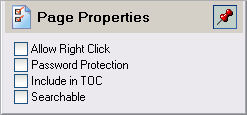
- Selecting Your Right Click Options - To allow users to use their right click mouse menu, click on each '
 Page' and place a check by the 'Allow Right Click' option within the 'Page Properties' section (This function is only available if you've selected the 'Custom' right click option within the 'Options' - 'Security' section -- step five within the wizard).
Page' and place a check by the 'Allow Right Click' option within the 'Page Properties' section (This function is only available if you've selected the 'Custom' right click option within the 'Options' - 'Security' section -- step five within the wizard). - Password Protecting Individual Files - To password protect individual pages, click on each '
 Page' and place a check by the 'Password Protection' option within the 'Page Properties' section (This function is only available if you've selected 'Password' - 'Selected Pages' under 'Security Type' within the 'Options' - 'Security' section -- step five within the wizard).
Page' and place a check by the 'Password Protection' option within the 'Page Properties' section (This function is only available if you've selected 'Password' - 'Selected Pages' under 'Security Type' within the 'Options' - 'Security' section -- step five within the wizard). - Defining Your Table of Contents - To specify which '
 Chapters' and/or '
Chapters' and/or ' Pages' should display within your TOC, click on each '
Pages' should display within your TOC, click on each ' Chapter' and/or '
Chapter' and/or ' Page' and place a check by the 'Include in TOC' option within the 'Page Properties' section. (For use with templates only)
Page' and place a check by the 'Include in TOC' option within the 'Page Properties' section. (For use with templates only) - Selecting Individual File Search Preferences - To specify which '
 Pages' should be searchable within your ebook, click on each '
Pages' should be searchable within your ebook, click on each ' Page' and place a check by the 'Searchable' option within the 'Page Properties' section.
Page' and place a check by the 'Searchable' option within the 'Page Properties' section.
For additional information on selecting your '![]() Chapter' and/or '
Chapter' and/or '![]() Page' options, visit the 'Selecting Your Chapter / Page Options' section.
Page' options, visit the 'Selecting Your Chapter / Page Options' section.
![]() Editing Your Templates
Editing Your Templates
Once you've completed the above steps, you're now ready to start editing your files. To do so, click on the 'Project' tab to view your files and then double click on the first file to begin editing. The file should open within the editor. You can also click on the file to highlight and then on the '![]() ' button.
' button.
Please note, you cannot edit files that have been created in another program. Only the original eBook Starter template pages may be edited within the editor. If you try to open a file created in another program within the editor, all you will see is the 'Preview' screen. However, the editor will not appear.
For further information, visit the 'Editing Your Templates' section.

Note: Your Table of Contents will automatically be created according to the options you selected within your 'Project' window.
![]() Customizing Your eBook's Settings
Customizing Your eBook's Settings
Once you're finished working with your files, your next step will be to customize all of your eBook's options. This will include all of the following:
- Selecting Your eBook's Options (Go to 'Project' - 'Options' or click on the 'Options' button on the eBook Starter toolbar) - Select options, such as General, Security, Toolbar, and Splash. (If you used the wizard to create your ebook, this step should have already been completed.)
- Customizing Your eBook's Toolbar Buttons (Go to 'Project' - 'Toolbar' on the eBook Starter toolbar and click on the 'Buttons' tab) - Select and edit your eBook's toolbar buttons.
- Customizing Your eBook's Toolbar Bookmarks (Go to 'Project' - 'Toolbar' on the eBook Starter toolbar and click on the 'Bookmarks' tab) - Select and edit your eBook's bookmarks.
- Working with Variables (Go to 'Project' - 'Variables' on the eBook Starter toolbar) - Scan your template for variables.
- Editing Your System Pages (Go to 'Project' - 'System Pages' on the eBook Starter toolbar ) - Edit your eBook's system pages, such as About, Shareware and Password Protection pages. Please note, portions of your system pages, such as your ebook title, will automatically be included when you edit the variables within the 'Variables' section. For further information on variables, visit the 'Working with Variables' section.
![]() Compiling Your eBook
Compiling Your eBook
When you've finished editing your eBook and selecting your options, your final step will be to compress your files into the EXE eBook format. This procedure is better known as compiling your eBook.
You can compile your eBook in one of two ways:
- Click on the 'Compile' icon on the toolbar.
- Go to 'Project' - 'Compile' on the toolbar.
A 'Confirm' window will appear displaying all of the options you have selected for your eBook. Read through the options to ensure the settings are correct. If you need to make some changes, click on 'No.' If you're ready to compile your eBook, click on 'Yes.'
![]() Uploading Your eBook to Your Server
Uploading Your eBook to Your Server
When you've completed your eBook, your next step will be to upload your new eBook to your server. To do so, you'll need to either use an FTP program or your 'Control Panel' through your web host. For additional information, see the 'File Transfer Protocol' section.
Your eBook should be uploaded to your server in 'Binary' mode.
Make sure you upload the correct file. Your ebook will have the filename you selected within the 'Options' section (Step 3 within the Wizard) -- followed by an EXE extension. So, for example, if you called your ebook dog_grooming, your filename would be dog_grooming.exe.
When you create an ebook, the system creates a folder that contains your ebook's files (template, text, images, etc.), a folder that contains your ebook's system files (toolbar buttons, logo, variables, etc.), your ebook's project file and your actual ebook file.
If you called your ebook dog_grooming, here's what these folders and files will be called:
- dog_grooming.files (template, text, images, etc.)
- dog_grooming.system (toolbar buttons, logo, variables, etc.)
- dog_grooming.ebp (ebook settings)
- dog_grooming.exe (your ebook)
The only file you'll need to upload to your server is your ebook.
 Creating a Download Page
Creating a Download Page
In order for your customers to download your eBook, you will need to create a 'Thank you' web page, also known as a 'Download' page. This page is simply a web page that includes some brief instructions in regard to downloading your eBook and a download link.
If you're using a payment processor, such as ClickBank or PayPal, to enable you to accept payment through your web site, they will ask you for the web address of your 'Thank you' page. This is the page your customers will be taken to once they complete their purchase.
To create a download link on your 'Thank you' page, most servers will allow you to simply link to the web address like this:
| <A HREF="http://www.yourdomain.com/ebook.exe">Download</A> |
Edit the text indicated in red to suit your needs. The link address must lead to your ebook file on your web server.
If this method of linking doesn't work for you, contact your server administrator for assistance.
In addition to including a download link you should also include the following note:
Please note: If you have an older operating system, including Windows 95, 98 or ME, or have upgraded from an older system, you will need to download and install a free Microsoft Windows Script Control plug-in to utilize the latest technologies included within this ebook.Download Problems:(1) If you're using a firewall program, such as Personal Firewall™, Gauntlet™ or ZoneAlarm™, this may also prevent you from downloading and opening the ebook file. You may need to disable the program until you complete your download.
|
HTML Code:
| Please note: If you have an older operating system, including Windows 95, 98 or ME, or have upgraded from an older system, you will need to download and install a free Microsoft <A HREF="http://www.microsoft.com/downloads/details.aspx?FamilyId=D7E31492-2595-49E6-8C02-1426FEC693AC&displaylang=en"> Windows Script Control </A>plug-in to utilize the latest technologies included within this ebook.<BR> <BR> <H3 ALIGN=Center> Download Problems: </H3> <P> (1) If you're using a firewall program, such as Personal Firewall™, Gauntlet™ or ZoneAlarm™, this may also prevent you from downloading and opening the ebook file. You may need to disable the program until you complete your download.<BR> <BR> (2) If you're using an anti-virus program, such as Norton™ or McAfee™, you may need to disable the program until you complete your download.<BR> <BR> (3) If you have recently upgraded to Windows XP SP2, you may be prevented from downloading the ebook. To start the download, you must first click on the Internet Explorer Information Bar, and then on 'Download File' to begin the download. |
If you're in need of a quality web host, HostGator is a professional web hosting company used by many Internet marketers. You can also find a wealth of quality web site templates at Template Monster.
Step by Step
-
Click on the 'Wizard' icon on the toolbar.
-
Select the 'Create an eBook from a template' option and click on 'Next.'
-
Click on the template you'd like to use and click on 'Next.'
-
Click through the rest of the wizard steps and select your options. When you get to the final screen (Finish 'step seven') click on 'Finish.' Your files should now be displayed within the 'Project' window.
-
Click on the 'Project' tab to view your project and create your story tree. Click on the '
 Insert Chapter' button to add a '
Insert Chapter' button to add a ' Chapter.' If you'd like to add a '
Chapter.' If you'd like to add a ' Child Chapter' within a chapter, click on your chapter to highlight and then on the '
Child Chapter' within a chapter, click on your chapter to highlight and then on the ' Add Child Chapter' button. To add '
Add Child Chapter' button. To add ' Pages' to your chapters, click on the chapter in which you'd like to add a page to highlight and then on the '
Pages' to your chapters, click on the chapter in which you'd like to add a page to highlight and then on the ' Add Default Page' arrow and select the page you would like to add.
Add Default Page' arrow and select the page you would like to add. -
Select your '
 Chapter' and '
Chapter' and ' Page' options. Click on each '
Page' options. Click on each ' Chapter' or '
Chapter' or ' Page' and click on the mini toolbar icons at the top of the 'Project' screen to select your preferred options.
Page' and click on the mini toolbar icons at the top of the 'Project' screen to select your preferred options. -
Click on the 'Project' tab to view your files and then double click on each file to begin editing.
-
Customize your ebook's settings -- Click on 'Project' - 'Variables' to edit the variables. Click on 'Project' - 'Toolbar' to edit the toolbar. Click on 'Project' - 'System Pages' to edit your About, Shareware and Password Protection pages. Click on 'Project' - 'Options' to edit your General, Security, Toolbar, and Splash screen options.
-
Click on the 'Compile' icon on the toolbar to compress your files into the EXE ebook format.
-
Upload your new eBook to your server.
-
Create your download page.
